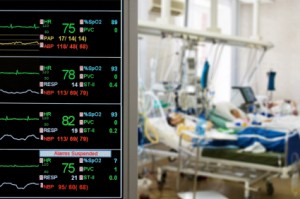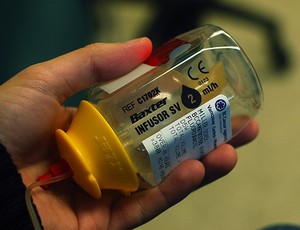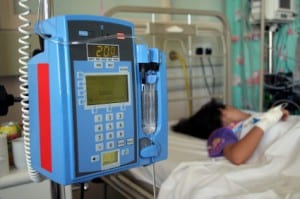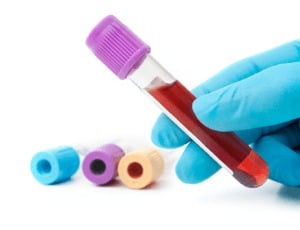Loss of guide wire as a complication of central venous catheterization

Here we report a case of lost guide wire following central venous line insertion” Najari et al (2018). Abstract: Many critically ill patients need aggressive procedures, such as central venous catheterization. The complication rate of central venous line placement is estimated to be 15%. Common complications include arterial puncture, hematoma, pneumothorax, hemothorax, arrhythmia, thoracic duct […]
Utility of central venous pressure measurement in renal transplantation

Our work sheds some light on the available published data in renal transplantation, together with data from other disciplines evaluating the utility of central venous pressure measurement” Aref et al (2018). Abstract: Adequate intravenous fluid therapy is essential in renal transplant recipients to ensure a good allograft perfusion. Central venous pressure (CVP) has been considered […]
Establishing catheter-related bloodstream infection surveillance to drive improvement

This article describes the journey of one hospital trust to set up a surveillance process for CRBSI across all specialties of the trust and to reduce CRBSI” Hallam et al (2018). Abstract: BACKGROUND: Catheter-related blood stream infections (CRBSI) are an important complication of central venous access devices but are often poorly measured. This article describes […]
Cardiac tamponade by peripherally inserted central catheter in preterm infants

To determine the incidence of pericardial effusion with cardiac tamponade in preterm infants in a pediatric intensive care unit, with emphasis on the relationship between pericardial effusion and peripherally inserted central catheter, and to evaluate the role of bedside ultrasound in approaching these cases” Barreiros et al (2018). Abstract: OBJECTIVE: to determine the incidence of […]
Adverse events related to extended-dwell peripheral intravenous access

Midline catheters (MCs) may be useful to avoid repeated venipuncture in patients requiring prolonged intravenous infusions with limited adverse events (AEs)” Campagna et al (2018). Abstract: Midline catheters (MCs) may be useful to avoid repeated venipuncture in patients requiring prolonged intravenous infusions with limited adverse events (AEs). We analyzed 2 Italian hospital databases to ascertain […]
Incidence of symptomatic upper limb venous thrombosis associated with midline catheters

The evaluation of the incidence of symptomatic upper limb venous thrombosis (ULVT) associated with midline catheters in patients admitted to the hospital” Lisova et al (2018). Abstract: AIM: The evaluation of the incidence of symptomatic upper limb venous thrombosis (ULVT) associated with midline catheters in patients admitted to the hospital. METHODS: The frequency of symptomatic […]
Persistent left-sided SVC is present in approximately 0.3% to 0.5% of the population

A review of a computed tomography (CT) scan of the chest with contrast done on a prior admission revealed a duplicated SVC on the left side that had not been reported in the original CT scan interpretation” Paik et al (2018). Abstract: Central venous catheters are placed in approximately five million patients annually in the […]
Incidence of infusion therapy related complications in home-based settings

Home-based medical care is rapidly expanding in Japanese health care settings. We aimed to clarify the implementation status of drip injection with peripheral venous catheters (PVCs) and the incidence of related complications” Nakayama et al (2018). Abstract: BACKGROUND/AIMS: Home-based medical care is rapidly expanding in Japanese health care settings. We aimed to clarify the implementation […]
The “rapid atrial swirl sign” for assessing central venous catheter tip location

Central venous catheter (CVC) placement is a standard procedure in critical care. Ultrasound guidance during placement is recommended by current guidelines, but there is no consensus on the best method for evaluating the correct CVC tip position. Recently, the “rapid atrial swirl sign” (RASS) has been investigated in a limited number of studies” Korsten et […]
Risk factors related to peripherally inserted central catheter removal in neonates

We aimed to investigate the incidence and risk factors associated with nonselective removal of peripherally inserted central venous catheter (PICC) in neonates” Yu et al (2018). Abstract: We aimed to investigate the incidence and risk factors associated with nonselective removal of peripherally inserted central venous catheter (PICC) in neonates. In this prospective cohort study, neonates […]
How to manage intravenous fluid therapy in sepsis

Among critically ill adults, sepsis remains both common and lethal. In addition to antibiotics and source control, fluid resuscitation is a fundamental sepsis therapy. The physiology of fluid resuscitation for sepsis, however, is complex” Brown and Semler (2018). Abstract: Among critically ill adults, sepsis remains both common and lethal. In addition to antibiotics and source […]
Collaborative establishment of difficult vascular access approach

Our case report focuses on the complex establishment of iliac artery access for invasive blood pressure monitoring by initially cannulating the carotid artery” Horn et al (2018). Abstract: Tetra-amelia is a rare congenital disorder characterized by the absence of limbs. We describe the anesthetic management of a 29-year-old woman with tetra-amelia who underwent general anesthesia […]
Exploring the causes of peripheral intravenous catheter failure

This study examined catheter shape just after removal to evaluate the causes of catheter failure according to site” Murayama et al (2018). Abstract: The risk of peripheral intravenous catheter failure varies according to the insertion site. This study examined catheter shape just after removal to evaluate the causes of catheter failure according to site. This […]
Phlebitis-related peripheral venous catheterization and the associated risk factors

The phlebitis in individuals receiving intravenous (IV) treatment was higher than the rate defined by both the centers for disease control and prevention and IV nurses society. It may be recommended to assess phlebitis by VIP assessment scale and to take preventive measures specifically for development of phlebitis” Atay et al (2018). Abstract: BACKGROUND AND […]
Comparison of flow pressures in different 3-way infusion devices

In this study, we aim to determine the pressures generated in common 3-way infusion devices, using simple low-cost equipment available and currently in use in the operating theatre environment” Chua and Ratnavadivel (2018). Abstract: BACKGROUND: The use of multiple infusions through one cannula is an increasingly common practice in anaesthesia. High pressures in the line […]
Efficacy and safety of continuous infusions with elastomeric pumps

This study aimed to evaluate the efficacy and safety of continuous antimicrobial infusion using elastomeric pumps in an outpatient setting, while simultaneously documenting circulating antibiotic concentration exposure achieved with this mode of administration” Voumard et al (2018). Abstract: OBJECTIVES: This study aimed to evaluate the efficacy and safety of continuous antimicrobial infusion using elastomeric pumps […]
Clinical and financial effects of smart pump-electronic medical record interoperability

A pharmacist-led implementation of smart pump-EMR interoperability led to measurable, data-based improvements in i.v. medication safety and improved accuracy, timeliness, and efficiency of i.v. infusion documentation. Revenue was increased due to improved charge capture for outpatient i.v. infusions” Biltoft and Finneman (2018). Abstract: PURPOSE: The pharmacist-led implementation of a smart pump-electronic medical record (EMR) interoperability […]
Usefulness of ultrasonography for the evaluation of catheter misplacement

To assess whether ultrasonographic examination compared to chest radiography (CXR) is effective for evaluating complications after central venous catheterization” Kim et al (2018). Abstract: OBJECTIVE: To assess whether ultrasonographic examination compared to chest radiography (CXR) is effective for evaluating complications after central venous catheterization. METHODS: We performed a prospective observational study. Immediately after central venous […]
Guidewire-induced asystole following right internal jugular catheter placement

The guidewire-related complications are rare but sometimes it has significant morbidity and mortality. In this case report, we have a patient who developed asystole during catheter insertion which required transvenous pacemaker insertion” Arafa et al (2018). Abstract: Internal jugular venous catheters are widely used for hemodialysis as permanent vascular access in patients with severe peripheral […]
Multi-drug resistant bacteria and the role of central venous catheter lock-therapy

The objectives of this study were to analyse outcomes in cancer patients with LTCVC-associated infection, identify risks for unfavourable outcomes and determine the impact of MDR bacteria and antibiotic lock therapy (ALT) in managing such infections” Freire et al (2018). Abstract: Objectives: The management of long-term central venous catheters (LTCVCs) infections by multi-drug resistant (MDR) […]
Can the implantable port dead-volume put patients at risk?

“The dead-volume associated with injection ports used at our institution may be clinically significant, increasing errors in medication delivery and laboratory analysis” Kuntz et al (2018).
The compliance coach for improving central line care and reducing CLABSI

A compliance coach who audits central line maintenance and provides feedback and education to bedside nurses through timely, nonpunitive conversation is an effective addition to busy infection prevention departments” Buchanan et al (2018). Abstract: A compliance coach who audits central line maintenance and provides feedback and education to bedside nurses through timely, nonpunitive conversation is […]
Handgrip exercise reduces peripherally-inserted central catheter-related venous thrombosis

Handgrip exercise using an elastic ball daily for three weeks could decrease the incidence of peripherally-inserted central catheter-related venous thrombosis. The method is simple, with no negative consequence reported. Further studies are required to confirm this conclusion and to explore the optimal frequency of handgrip exercise” Liu et al (2018). Abstract: BACKGROUND: Peripherally-inserted central catheter-related […]
Mechanical complications of central venous catheter insertions

In this retrospective, multicenter observational study on 10 949 central venous catheter insertions, mechanical complications were rare. Preprocedural coagulopathy, number of needle passes, and arterial puncture were associated with grade 2-4 bleeding” Björkander et al (2018). Abstract: BACKGROUND: Incidence and risk factors for complications after insertion of central venous catheters have previously been reported for […]
Central venous catheter repair is successful in children with intestinal failure

CVC repair is a highly successful procedure with a low risk for infection. Catheter repair should be considered whenever possible as it may extend the lifetime of the catheter and decrease the risk for vascular access loss” Chan et al (2018). Abstract: PURPOSE: Damaged central venous catheters (CVCs) are commonly repaired to avoid line replacement […]
Dialysis catheter-related bloodstream infections in patients receiving emergency hemodialysis

Patients receiving emergency-only hemodialysis via tunneled catheters have a high CRBSI rate compared to infection rates previously reported in patients receiving scheduled maintenance hemodialysis. Increased CRSBI risk likely contributes to the increased morbidity and mortality seen in ESRD patients receiving emergency-only hemodialysis” Zhang et al (2018). Abstract: BACKGROUND: An estimated 6500 undocumented immigrants with end-stage […]
How to prepare children and families for venipuncture

To report the experience of development of an application program to prepare child and family for venipuncture” Cunha et al (2018). Abstract: OBJECTIVE: To report the experience of development of an application program to prepare child and family for venipuncture. METHOD: Experience report on an application program developed in the professional nursing master’s degree program […]
What are the antidotes for calcium gluconate extravasation?

The aim of the present study is to analyze the beneficial effects of four possible local antidotes for calcium gluconate extravasation: hyaluronidase, sodium thiosulfate, triamcinolone acetonide and physiological saline solution” Pacheco Compaña et al (2018). Abstract: BACKGROUND: Calcium Gluconate Extravasation is a process that can cause serious lesions, such as necrosis and calcification of the […]
Treatment of radiographic and magnetic resonance contrast medium extravasation

In addition to anaphylactic reactions induced by contrast media (CM), extravasation is an adverse reaction that occurs immediately, requires special treatment, and attention” Hrycyk et al (2018). Abstract: In addition to anaphylactic reactions induced by contrast media (CM), extravasation is an adverse reaction that occurs immediately, requires special treatment, and attention. Since radiologists are often […]
Risk factors of contrast media extravasation during intravenous contrast-enhanced CT scans

To evaluate the frequency, outcome, and risk factors of intravenous contrast media (CM) extravasation during contrast-enhanced CT scans in a large population” Hwang et al (2018). Abstract: OBJECTIVE: To evaluate the frequency, outcome, and risk factors of intravenous contrast media (CM) extravasation during contrast-enhanced CT scans in a large population. METHODS: After institutional review board […]

